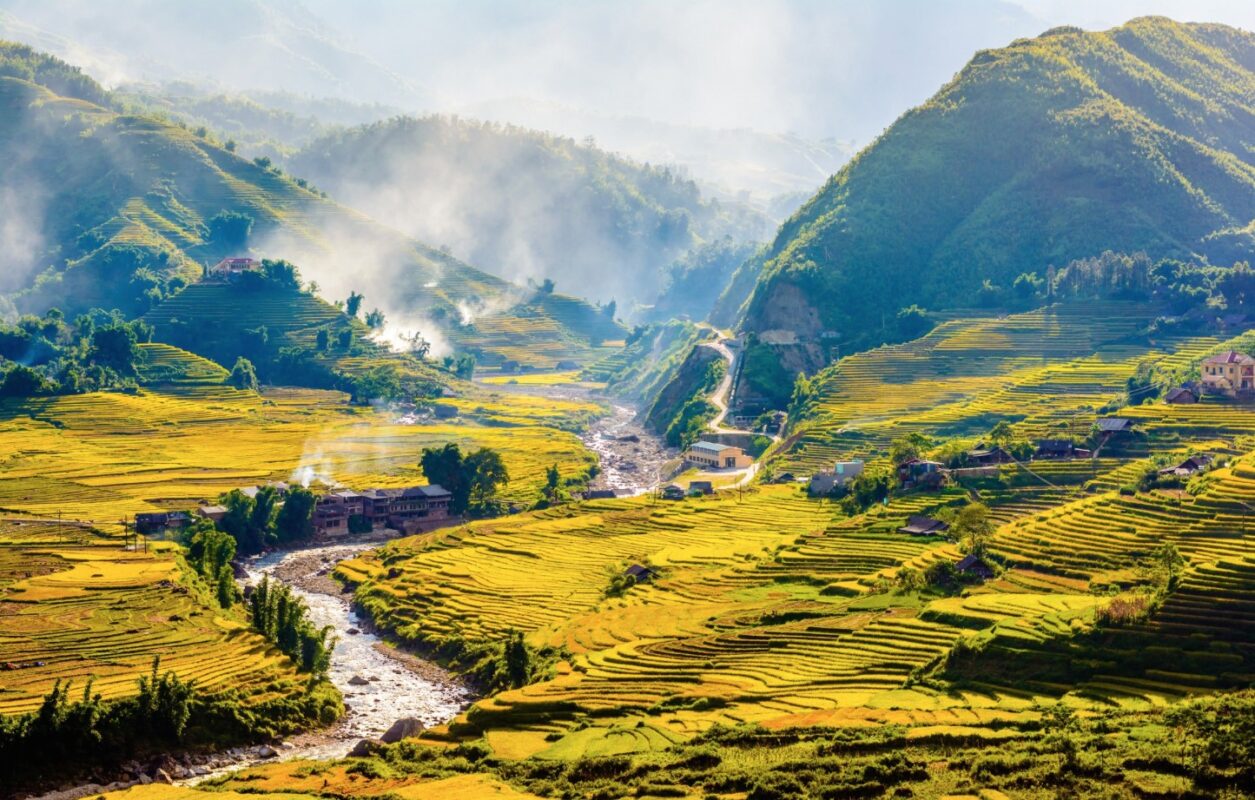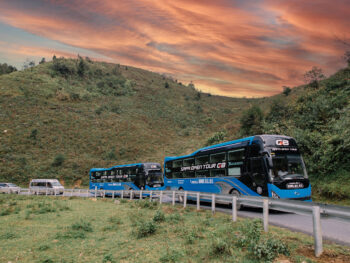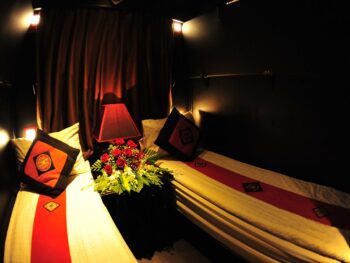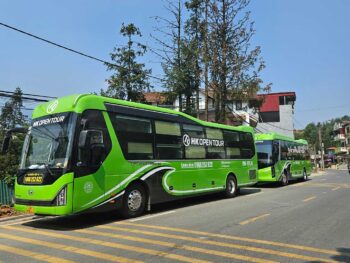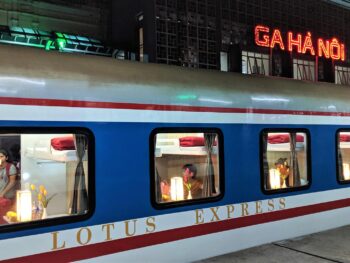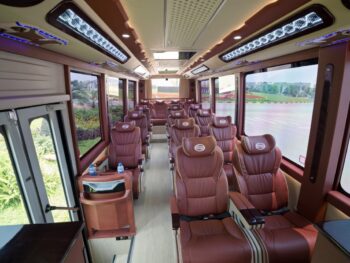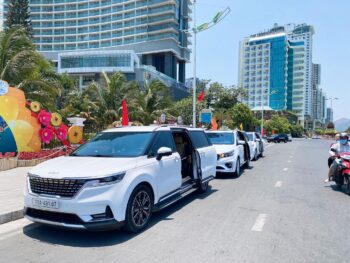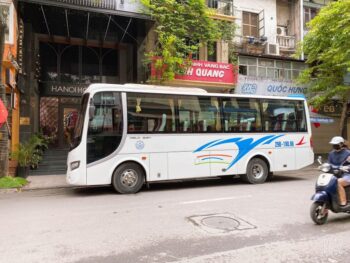Introduction
Close your eyes and listen to Sapa in August: the staccato of rain pelts tin roofs like a drummer’s roll, swollen streams hum a low, steady bass, and warm mist whispers through Vietnam’s northern highlands as the monsoon crescendos into its wildest, most untamed act. Sapa weather in August isn’t just a forecast—it’s a sensory masterpiece of heat, torrential rain, and lush transformation, a living symphony begging to be explored. This month brings warm days averaging 26–30°C, the wettest peak of the monsoon with 300–350mm of rain, and a landscape so alive it pulses with hidden rhythms—nature’s roars, cultural whispers, and ecological secrets few travelers dare to hear. In this unconventional guide, we’ll unravel the climate’s notes with precision, lead you to offbeat soundstages tied to August’s deluge, tune your packing list to the monsoon’s melody, and compose a 3-day sensory itinerary to immerse you in Sapa’s August magic. Whether you’re a trekker chasing muddy trails, a listener drawn to rain’s cadence, or a seeker of the highlands’ untold stories, this Sapa monsoon symphony offers an adventure that echoes long after the last drop falls.
Sapa Weather in August: The Monsoon’s Final Note

Temperature Soundscape
August sweeps into Sapa with warm, tropical tones, daytime highs ringing in at 26–30°C (79–86°F)—a subtle softening from July’s 27–31°C, yet still thick with humid resonance. Lower elevations like Sapa town and Sin Chai simmer under a sun often masked by clouds, while nights cool to a balmy 19–23°C (66–73°F)—a gentle lullaby at higher spots like Tram Ton Pass (1,900m), where breezes cut through the mist. Compared to July’s warmer prelude or September’s drier coda (25–29°C), Sapa weather in August plays a balanced chord of heat and rain—a finale that’s both intense and soothing. Based on data from Vietnam Meteorological Department.
Rainfall Rhythm & Humidity
Rainfall peaks at 300–350mm, making August Sapa’s wettest month—a relentless orchestral downpour with 20–25 rainy days. Showers strike daily, often 60–90 minutes of torrential force, peaking in late mornings and afternoons with a thunderous roar that echoes off the peaks. Mornings (6–9 AM) might tease with brief silences, but the rhythm resumes by noon, flooding trails and swelling rivers. Humidity climbs to 90–95%, saturating the air with a sticky, misty pulse that fogs lenses, slicks skin, and amplifies the highlands’ green chorus—think croaking frogs and rustling leaves. Outpacing July’s 250–300mm and setting the stage for September’s 200–250mm, August’s rain is the monsoon’s climactic note.
Visibility Echoes
Thick fog and clouds mute Sapa’s vistas, reducing visibility to whispers—sometimes just 10–20 meters in Ta Phin or Sin Chai. Landmarks like Fansipan or Thanh Phu Waterfall fade into gray silence, only to sing briefly when showers part the mist for 10–15 minutes of vivid clarity—rain-washed greens and distant ridges emerge like a fleeting solo. Unlike July’s slightly sharper interludes or September’s clearer refrains, Sapa weather in August cloaks the highlands in a moody, muffled ambiance—perfect for tuning into its soundscape over its sights.
The Monsoon’s Hidden Beat
August’s rain doesn’t just soak—it reshapes. Swollen streams amplify Sapa’s acoustics—waterfalls thunder, frogs croak in unison (over 30 species thrive in the wet), and wind whistles through bamboo groves. Compared to July’s warm-up or September’s fade-out, August is the monsoon’s grand finale—a sensory crescendo that’s as much about hearing as seeing.
Why Sapa Sings in August?
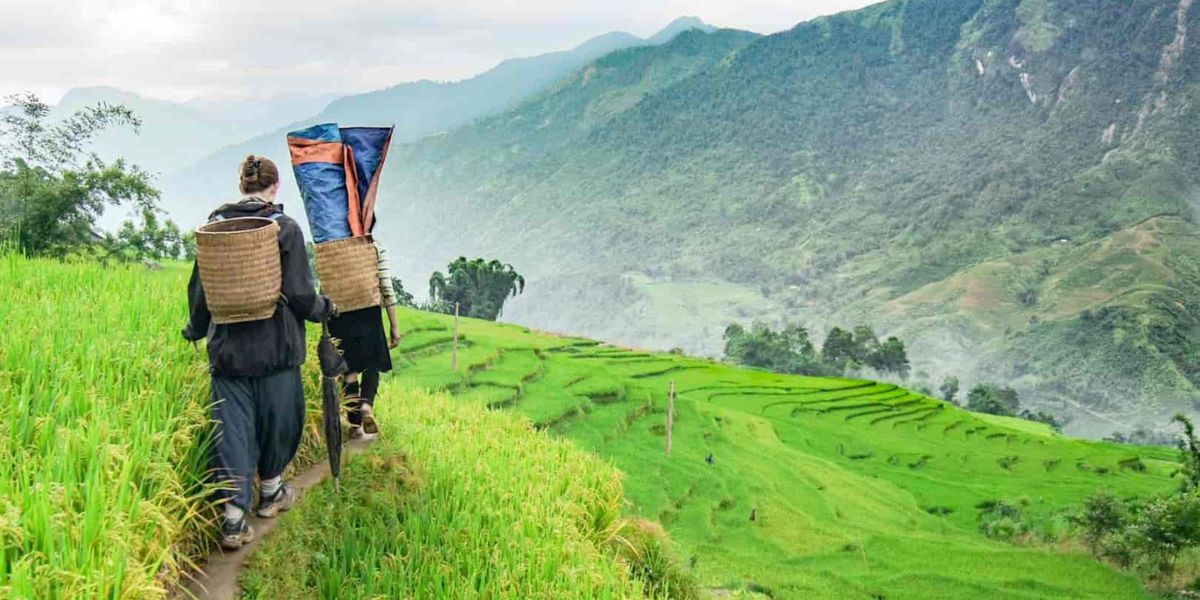
Rice Terraces in Full Chorus
August’s deluge pushes Sapa’s rice terraces to their lushest peak—the Sapa rice terraces August hum with a dense, reflective green as rice plants near harvest, their waterlogged surfaces mirroring the sky’s misty refrain. Ta Phin Valley offers secret overlooks off the main trail (ask locals for “đồi cao”—high hill), while Sin Chai’s terraces resonate with quiet streams—fewer tourists here mean you hear the rain’s patter undisturbed. Pro tip: stand still post-shower—water drips off rice stalks like a delicate chime, a sound lost in drier months.
Waterfalls as Nature’s Drums
The monsoon turns Sapa’s waterfalls into thunderous percussionists. Silver Waterfall (12 km from Sapa, $1 USD entry) beats a 100-meter roar, its mist a cooling counterpoint to August’s warmth—hear it from 300 meters out. Thanh Phu Waterfall, a hidden gem near Ban Ho (25 km), drums fiercely through forest—its sound drowns out all else after August’s rains swell it threefold. Smaller falls like Giang Ta Chai pulse with bamboo’s rustle—nature’s rhythm section in full swing.
Trekking Through the Rain’s Melody
Warm, wet days at 26–30°C tune Sapa’s trails into a muddy, melodic adventure. Ta Phin Valley’s 12-km loop hums with swollen streams and Red Dao chants—August’s rain softens the earth into a squelching bassline. Sin Chai’s 5–7 km trek whispers with Hmong lullabies from stilt houses—fewer trekkers let you hear the wind’s whistle. The 2-day Fansipan climb ($50–70 USD with guide) roars with slick rocks and foggy silence—summit views fade, but the journey’s wet cadence is the reward. August’s Sapa monsoon symphony plays loudest on foot.
Cultural Harmonies in the Wet
Sapa’s ethnic communities compose their own August score. In Sin Chai, Hmong elders perform flood rituals—bamboo flutes ($3 USD) and rice wine offerings ($1 USD/shot) appease river spirits swollen by rain, a tradition born from centuries of monsoons. Ta Phin’s Red Dao sing work songs under porches, their voices weaving with the rain’s beat—join them for a $5 USD herbal bath, a steamy respite. Sapa’s night market under tarps chants with vendor calls—grilled corn ($1 USD) sizzles as rain drums overhead. August’s deluge inspires a cultural resilience you won’t find in drier seasons.
Hidden August Gems
Listen closer: August awakens Sapa’s wild chorus—frogs croak in rice paddies (spot the emerald-green Cochinchina frog), rare birds like the Rufous-throated Partridge call from misty forests (bring binoculars), and quieter trails let you hear the highlands breathe. Ecologically, rain flushes nutrients into soil, reviving bamboo and ferns—Sapa’s green lung sings loudest now, a secret travelers rarely notice.
Challenges of August’s Monsoon Score
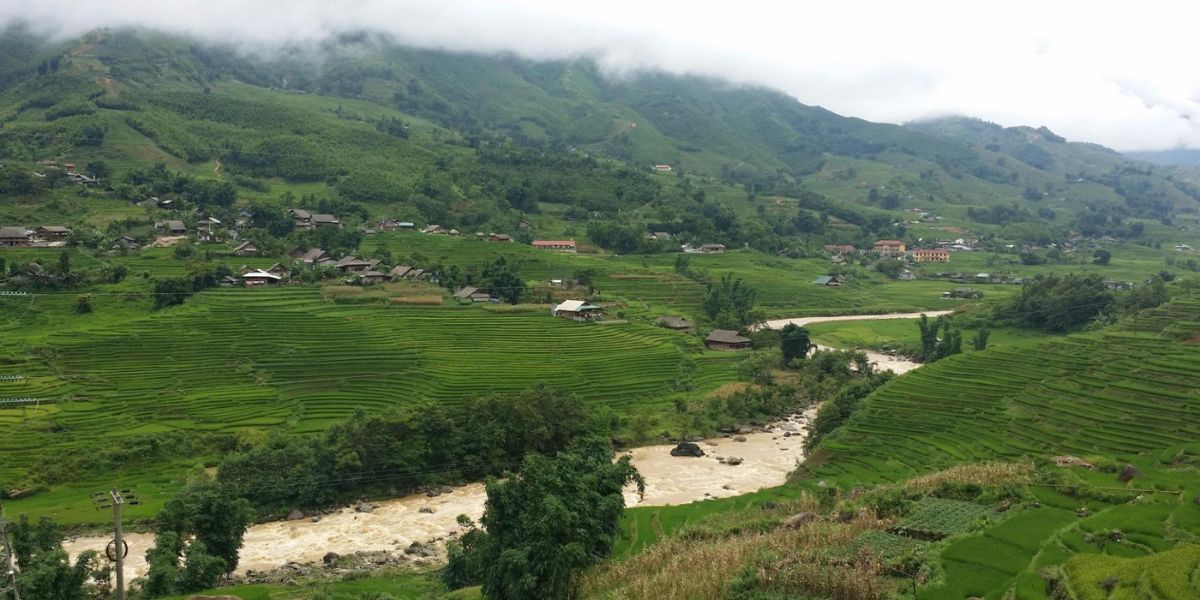
Relentless Rain Cadence
Heavy, constant showers (300–350mm) flood Sapa daily—trails like Ta Phin turn into muddy rivers, bamboo bridges sway, and roads to Thanh Phu slick up fast. Mornings (6–9 AM) offer brief pauses; afternoons drown in rain—timing is your conductor. Motorbikes skid, boots sink—August’s rhythm demands precision.
Sticky Humidity Bassline
Humidity at 90–95% deepens 26–30°C warmth into a sticky, resonant hum—sweat beads in Sin Chai, clothes cling in Sapa town, and drying gear feels futile. Nights (19–23°C) stay muggy—sleep turns restless without fans or breeze. The air’s weight amplifies every sound, from rain to breath.
Foggy Silence
Dense mist mutes Sapa’s vistas—Fansipan vanishes, Ta Phin’s valleys fade to whispers. Visibility drops to 10–20 meters—clearings are rare, fleeting notes. Photographers lose sharp shots; trekkers lose bearings—August’s fog silences the eyes but awakens the ears.
Tuning Solutions
Waterproof gear (ponchos, boots) keeps rain’s beat at bay—listen to its rhythm for navigation (streams guide you). Cooling fans and rice bags (absorb moisture, $1 USD) mute humidity’s drone. Indoor escapes like Sapa’s night market or Ta Phin’s porches turn fog into a cozy coda—August’s challenges are its melody with the right tune.
What to Pack for Sapa’s August Symphony
Clothing Ensemble
Pack quick-dry shirts (polyester, $15–25 USD) and breathable pants/shorts—cotton drowns in humidity. A hooded rain jacket (e.g., Marmot PreCip, $80–100 USD) is your shield, paired with a waterproof hat ($10–20 USD) for rain and rare sun. Layer a long-sleeve top or fleece (19–23°C nights)—breezes hit high trails. Bring 4–5 moisture-wicking socks ($5–10 USD/pair)—wet feet echo blisters.
Footwear Tempo
Waterproof boots with lugs (e.g., Columbia Newton, $100–130 USD) grip Ta Phin’s mud—break them in first. Sandals (e.g., Chaco Z/1, $80 USD) offer wet relief at homestays—barefoot indoors hums with local custom. Pack a waterproof shoe pouch ($5 USD)—soggy boots stay contained.
Gear Instruments
A rain poncho ($5–10 USD) backs your jacket, while a waterproof backpack (20L, e.g., Sea to Summit, $100 USD) or cover ($15 USD) guards gear—electronics hate August’s wet. An audio recorder ($30 USD, e.g., Zoom H1n) captures rain’s symphony—frogs and falls shine. A USB fan ($15 USD) or cooling towel ($10 USD) softens humidity; a 10,000mAh power bank ($20 USD) keeps tech alive—outlets falter in rain.
Health & Comfort Notes
Sunscreen (SPF 50+, $10 USD) fights UV through clouds—August’s index hits 7–9. Bug spray (DEET 30%, $8 USD) repels wet-season mosquitoes—spray twice daily. Hydration salts (e.g., LMNT, $1 USD/packet) and a 2L bladder ($25 USD) counter heat—3–4L/day is your tempo. Anti-fungal cream ($10 USD) heals soaked feet; a first-aid kit ($15 USD) with bandages, antiseptic, and ibuprofen tunes out slips or bites.
August’s Hidden Notes
Download our —add a bamboo flute ($3 USD) to play along, rice bags ($1 USD) to dry gear (locals’ trick), and binoculars ($30 USD) for rare birds—August’s extras amplify the experience.
Sapa’s August Soundstages: Where to Listen
Sin Chai Village
Ten kilometers from Sapa, Sin Chai whispers Hmong secrets amid misty terraces. Trek 5–7 km from the main road (motorbike drop-off, $1 USD)—August’s rain softens paths into a squelching lullaby. Hear elders’ flood chants under stilt houses—stay in a homestay ($8–15 USD/night) for rice wine ($1 USD) and frog croaks at dusk. A quiet retreat where rain’s rhythm reigns.
Thanh Phu Waterfall
Twenty-five kilometers near Ban Ho, Thanh Phu roars as August’s hidden anthem. A 4-km hike from the road (taxi, $15 USD) winds through muddy forest—its 50-meter drop thunders threefold in peak rain, audible 400 meters out. Stand close—mist cools, sound deafens. Pair with a Ban Ho homestay ($10–15 USD) for Tay songs—a rare monsoon stage.
Ta Phin Valley
Twelve kilometers from Sapa, Ta Phin hums with Red Dao melodies and swollen streams. A 12-km loop trek (5–7 hours) weaves through waterlogged terraces—August’s mud slows you, but rain’s patter and Dao work songs lift the spirit. Pause for a $5 USD herbal bath—steam blends with rain’s beat. A muddy, melodic masterpiece.
Sapa Night Market Under Rain
In Sapa town, the night market (5–10 PM) chants under tarps—vendors’ calls for grilled corn ($1 USD) and rice wine ($1 USD) sync with rain’s percussion on plastic. Browse Hmong embroidery ($5–20 USD)—the bustle hums louder in August’s wet. A cultural crescendo when trails flood.
Offbeat Gem: Tram Ton Pass
Fifteen kilometers from Sapa, Tram Ton Pass (1,900m) offers foggy stillness—August’s rain quiets tourists, leaving rare bird calls (Rufous-throated Partridge) and wind’s whistle through pines. Motorbike up ($1 USD parking)—stand in mist, listen to nature’s solo. A highland secret tied to rain’s ecological surge.
Tuning Your August Adventure in Sapa
Travel Rhythms
Motorbiking in August’s rain demands slow beats—rent a bike with wet tires ($6–10 USD/day) in Sapa, test brakes, and crawl (15–20 km/h) on slick roads like Ta Phin’s. Carry a repair kit ($5 USD) and 1L fuel ($1 USD)—rural pumps vanish. From Lao Cai (35 km, night train from Hanoi $25–35 USD), take a shuttle (45 minutes, $3–5 USD) or taxi ($20 USD)—wet roads favor 4WD. We also provide transfer services from Hanoi to Sapa—book ahead for convenient.
Shelter Melodies
Homestays in Sin Chai or Ta Phin ($8–15 USD/night) hum with rain on tin roofs—seek mosquito nets and porches; fans are rare. In Sapa town, AC hotels like Silk Path ($80–120 USD) or Sapa Horizon ($60–100 USD) mute humidity—book 3–4 weeks ahead for August’s off-season deals. Check for power backup—rain shorts grids.
Daily Tempo
For August trekking tips Sapa, strike outdoor notes early (6–10 AM)—Ta Phin or Sin Chai dry briefly pre-noon. Shift indoors by afternoon—Sapa’s night market, cafes like Le Gecko ($2 USD coffee), or the Sapa Museum (free, 9 AM–5 PM) for Hmong history. Pack rain gear and earbuds—listen to the monsoon’s beat.
3-Day Sensory Itinerary
- Day 1: Arrive Lao Cai 5:30 AM (night train), shuttle to Sapa by 7:00 AM. Check into Sapa Horizon ($60–100 USD), breakfast at The Hill Station ($5 USD)—pho and coffee. Explore Sapa Museum (9–11 AM), lunch at Sapa O’Chau ($6 USD)—grilled pork. Afternoon rain hits—night market (5–8 PM), dinner ($5 USD)—thang co. Sleep to rain’s lullaby.
- Day 2: Motorbike to Ta Phin (6:30 AM, 12 km), trek 12 km (7 hours)—hear streams and Dao songs. Lunch at a homestay ($3 USD)—com lam. Herbal bath ($5 USD), stay overnight ($10–15 USD)—record frog choruses at dusk.
- Day 3: Motorbike to Tram Ton Pass (6:30 AM, 15 km)—listen to birds in fog (1–2 hours). Return to Sapa, lunch at Gem Valley ($6 USD), shuttle to Lao Cai (3:00 PM)—train home (8:30 PM).
FAQs About Sapa Weather in August
“Is August too wet for Sapa’s song?”
Peak rain (300–350mm) floods daily, but the symphony shines—gear keeps you in tune.
“How warm does August play?”
Warm at 26–30°C—humid, but rain cools; hydrate with 3–4L/day.
“Do terraces still sing in August?”
Yes, fullest and greenest—rain’s mirror adds a reflective note.
“What’s an indoor harmony in August?”
Night market or cafes—vendor chants hum under tarps.
“What sounds define August in Sapa?”
Frogs, falls, and rain—a wild chorus you’ll hear nowhere else.
Conclusion
Sapa weather in August is a hidden symphony—warm, wet days, misty echoes, and monsoon majesty unveiled in Vietnam’s northern highlands. From the lush chorus of Sapa rice terraces August to the drumming of Thanh Phu Waterfall, this month invites you to listen, trek, and feel a Sapa few dare to know. Wondering the best time to visit Sapa? August’s wild notes strike a chord for those who crave the untamed. Pack your gear, tune your senses, and unravel Sapa’s monsoon symphony this August—its echoes linger long after.



